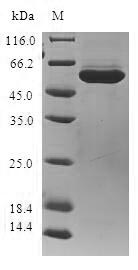Recombinant Human Aldo-keto reductase family 1 member B10 (AKR1B10) is expressed in E. coli and contains the complete protein region spanning amino acids 1-316. The protein carries an N-terminal GST tag and shows purity levels above 90% when analyzed by SDS-PAGE. This product is designed strictly for research purposes and cannot be used in clinical settings.
AKR1B10 belongs to the aldo-keto reductase superfamily and appears to play an important role in converting aldehydes and ketones to their corresponding alcohols. The enzyme participates in multiple metabolic pathways and has drawn considerable attention from researchers studying detoxification mechanisms and lipid metabolism.
Potential Applications
Note: The applications listed below are based on what we know about this protein's biological functions, published research, and experience from experts in the field. However, we haven't fully tested all of these applications ourselves yet. We'd recommend running some preliminary tests first to make sure they work for your specific research goals.
Human AKR1B10 is an aldo-keto reductase that requires precise folding, proper cofactor binding (NADPH), and specific active site formation for its enzymatic activity in carbonyl metabolism. The E. coli expression system cannot provide the optimal eukaryotic folding environment and may lack specific post-translational modifications. The large N-terminal GST tag (∼26 kDa) may sterically interfere with the protein's active site or functional domains, potentially disrupting enzymatic activity. While the protein may be soluble, the probability of correct folding with full enzymatic activity requires experimental validation.
1. Enzyme Kinetics and Substrate Specificity Studies
This application carries a significant risk without functional validation. AKR1B10 enzymatic activity requires precise active site formation and cofactor binding that may be compromised by the large GST tag. If correctly folded and active (verified through activity assays), the protein may be suitable for kinetic studies. If misfolded/inactive (unverified), kinetic measurements will yield biologically meaningless results. The GST tag may sterically block substrate access to the active site.
2. GST Pull-Down Assays for Protein-Protein Interactions
This application is technically feasible but carries limitations. The GST tag enables efficient pull-down experiments, but the large tag may create artificial interaction surfaces or sterically block genuine binding sites. If correctly folded (verified), limited interaction studies may be possible. If misfolded/unverified, there is a risk of identifying non-physiological binding partners.
3. Antibody Development and Validation
This application is highly suitable as antibody development relies on antigenic sequence recognition rather than functional enzymatic activity. The full-length protein provides comprehensive epitope coverage, though antibodies may not efficiently recognize conformational epitopes if the GST tag alters protein folding.
4. Structural and Biophysical Characterization
These studies are essential priority applications for determining folding status. Techniques should include size-exclusion chromatography to assess the impact of the GST tag on protein size, circular dichroism spectroscopy to evaluate secondary structure, and activity assays to validate functional folding. However, the GST tag may interfere with crystallization for high-resolution structural studies.
5. Inhibitor Screening and Drug Discovery Research
This application carries a high risk without functional validation. Inhibitor screening requires native enzyme conformation and activity. The GST tag may alter the active site configuration or create artificial binding pockets, leading to misleading screening results. If correctly folded and active (verified), limited screening may be possible.
Final Recommendation & Action Plan
The E. coli expression system with a large GST tag poses significant challenges for producing a functionally active AKR1B10 enzyme. Begin with Application 4 (Structural Characterization) to assess folding quality through SEC, CD spectroscopy, and validate enzymatic activity using standard AKR substrates and NADPH cofactor. Applications 1, 2, and 5 require rigorous functional validation before proceeding. Application 3 (antibody development) can proceed immediately. Consider using tag-free or smaller-tag constructs for critical functional studies, and always include appropriate controls to account for potential tag interference in data interpretation.






